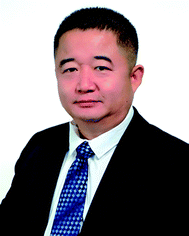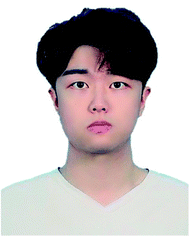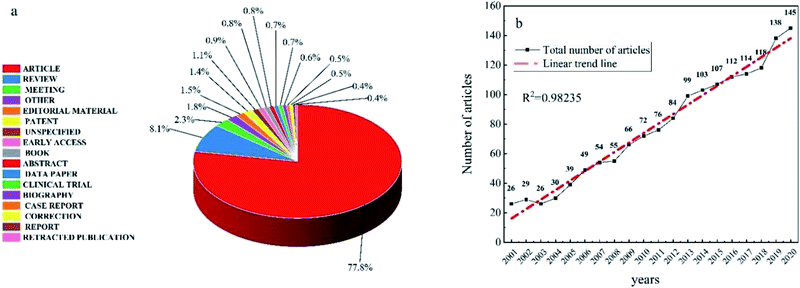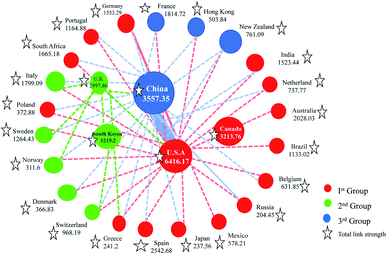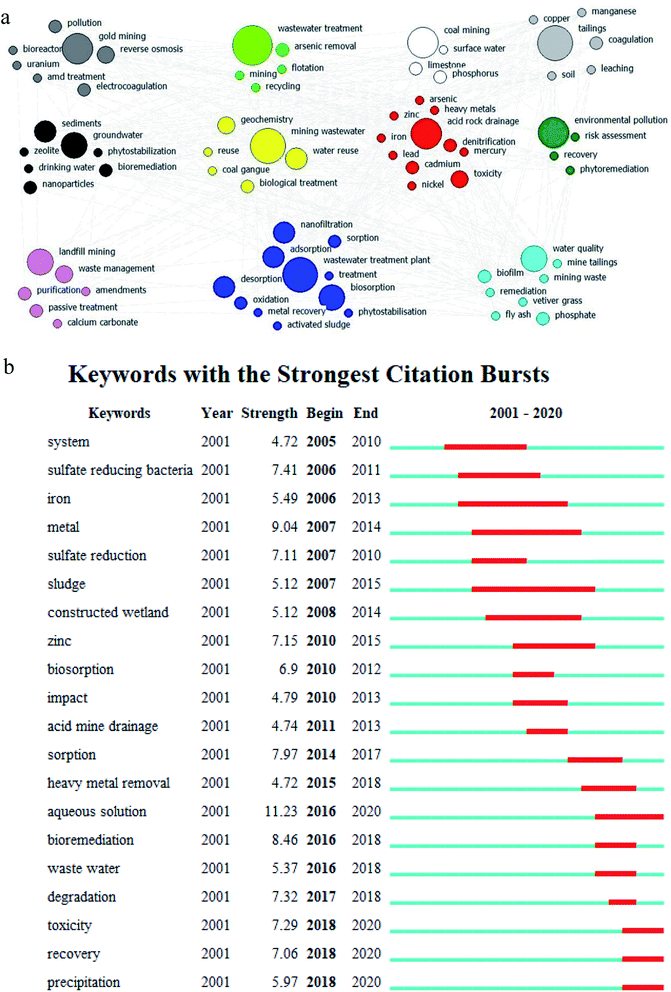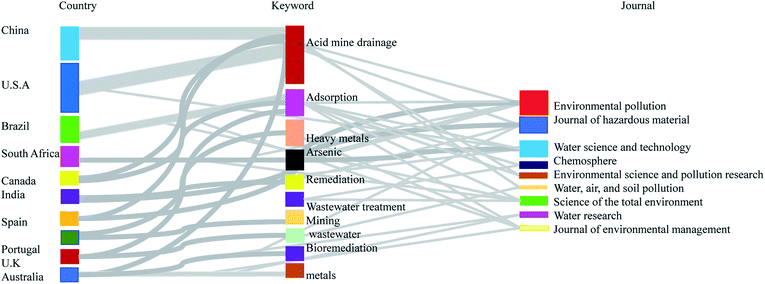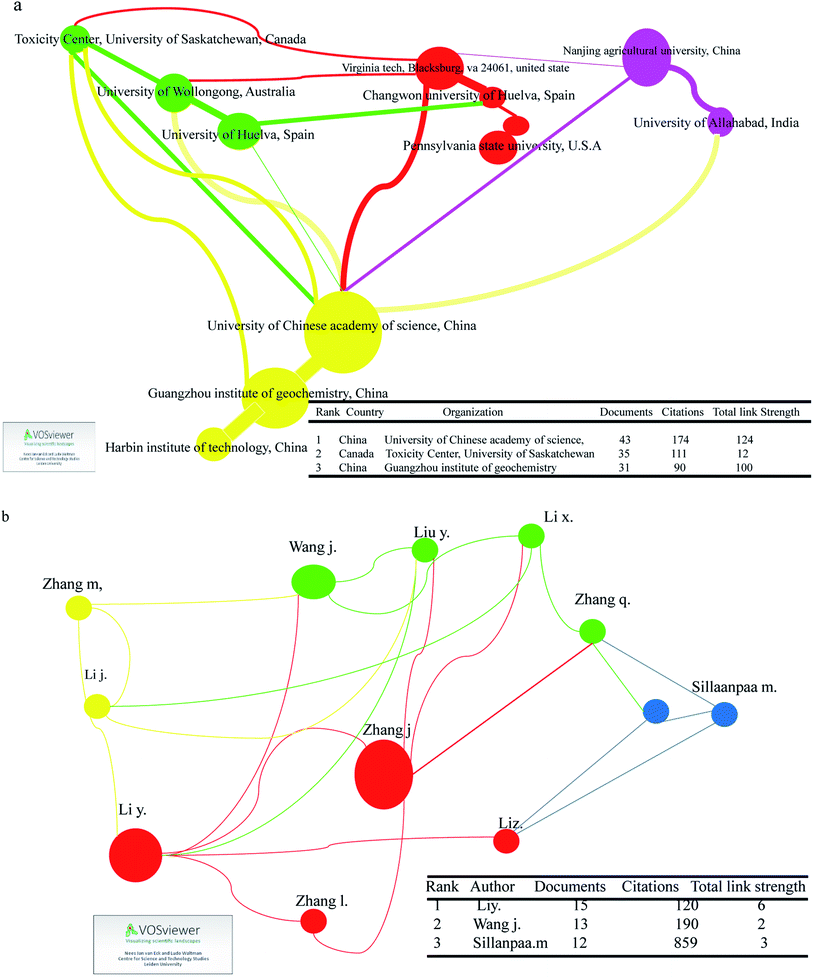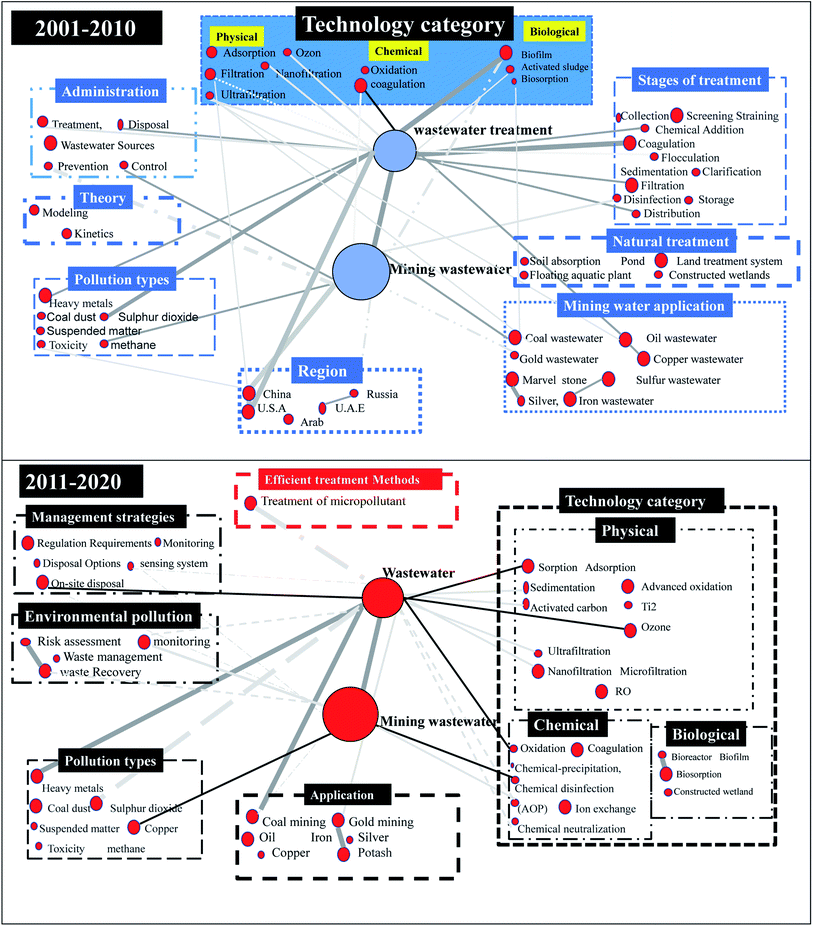 Open Access Article
Open Access ArticleGlobal research progress on mining wastewater treatment: a bibliometric analysis
Aqib
Zahoor
a,
Guozhu
Mao
a,
Xinming
Jia
a,
Xiao
Xiao
b and
Jian Lin
Chen
 *cde
*cde
aSchool of Environmental Science and Engineering, Tianjin University, Tianjin, 300350, China
bDepartment of Infrastructure Engineering, Faculty of Engineering and Information Technology, The University of Melbourne, Grattan Street, Parkville, Victoria 3010, Australia
cDepartment of Science, School of Science and Technology, Hong Kong Metropolitan University, Good Shepherd Street, Ho Man Tin, Hong Kong SAR, China. E-mail: jchen@hkmu.edu.hk; Tel: +852 3120 2718
dShenzhen Research Institute of City University of Hong Kong, Shenzhen, 518057, China
eState Key Laboratory of Marine Pollution and Department of Chemistry, City University of Hong Kong, Tat Chee Avenue, Kowloon, Hong Kong, China
First published on 12th April 2022
Abstract
Mining wastewater treatment (MWWT) methods have played a vital role in sustainable water management in recent years. This bibliometric analysis summarized the scientific research improvement on MWWT and the assessment of future research. We employed bibliometric and social network analysis to quantitatively study 1542 research articles (published from 2001 to 2020) related to MWWT. The findings reveal that: (1) publications on MWWT have increased significantly since 2009, and researchers have intensively focused more on the application and optimization of current technologies such as membrane filtration systems, automatic variable filtration, advanced oxidation processes, and UV irradiation; (2) China and USA have the maximum number of research publications as well as are the centers in the international collaboration network, while Canada and European countries have produced a higher quality of papers; (3) through clusters of keywords and treatment technology analysis, the top three keywords are related to adsorption, oxidation, and activated sludge processes, corresponding to three types of mature wastewater treatment categories (physical, chemical, and biological); and (4) scientists have moved their focus to treatment technologies from the conventional to advanced ones for MWWT research. Finally, some problems and perspectives are presented, which might suggest current scientific hotspots and future research guidelines.
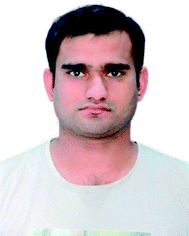 Aqib Zahoor | Aqib Zahoor, Ph.D. candidate in Environmental Science, School of Environmental Science and Engineering, Tianjin University, Tianjin, China, 300072. E-mail: E-mail: aqibzahahoor@tju.edu.cn, Current research interests: Investigation of Mining wastewater treatment technologies, adsorption technology, green infrastructure, and optimization of green space pattern. |
Environmental significanceModern mines as well as abandoned mines are responsible for significant environmental damage of water throughout the world. The treatment of mining wastewater is a major issue related to sustainable water resources management. Although many wastewater treatment technologies have been used to treat mining wastewater, the diversity of technologies makes it difficult for policy makers or investors to understand the research hotspots and technology development trends in this field. In this study, by bibliometric and social network analysis on recent mining water treatment research articles, it was found that China and U.S.A. have great research flow, and China has the greater international academic research influence, while scientists have moved their focus on treatment technologies from conventional to advanced ones in this field. The finding in this study proposed current scientific hotspots and future research guidelines such as policies, and guidelines cheap, high recovery, energy and time saving, and new treatment technologies. |
1. Introduction
Water pollution is a concern for the world due to the presence of various contaminants such as dyes,1 pesticides, medicines, phenolic compounds,2 heavy metals,3 as well as their negative impacts on the ecosystem.4,5 Despite being one of the sources of water pollution, mining industries play economic importance, such as technological innovation, benefits of education, and community improvement projects,6 generating much-needed employment and infusing revenue not just into the local community but also the nationwide economy, as can be seen from the statistical data from proceeding years.7,8Heavy metals seep into rocks, accumulating in raw materials, and releasing pollutants into the environment.3 All of this happens naturally, either as a result of rainfall, melting snow, or groundwater.9 Many ores, mining precious metals, such as gold (Au), copper (Cu),10 arsenic (As), mercury (Hg), cyanide, and uranium (U), contain high amounts of the poisonous metalloid ions.11–13 For example, arsenic in most cases comes from mine exploitation, as well as excavating, and regularly has connections to treasured minerals, including sphalerite, pyrite, and chalcopyrite.14 Arsenic generally dissolves during manufacture and then seeps into groundwater. The arsenic wastewater is poisonous and easily impacts human internal organs, leading to cancers.15
Many studies have found that heavy metal absorption in mining areas is extremely high due to mine tailings, disposal of high metal wastes,16 expanding industrial areas, leaded gasoline and paints,17 all of which can contaminate natural water bodies, soils, and sediments. Simultaneously, many pollutants can be found in mining effluent, including cyanide, ammonia, and heavy metals.18,19 Due to their proclivity for biological accumulation, high toxicity, and carcinogenicity at very low doses.20,21 heavy metals as a class of contaminants have gotten increasing attention.22–24 Moreover, mine-derived hard rock and liquid tailings waste can alter the chemistry of water and sediment25 as well as the release of contaminants that endanger aquatic ecosystems and human health.26,27 Therefore, mining industries and chemical facilities are considered the primary pollution sources,28 and their wastewater need to be treated before releasing into the environment.29 Hence, wastewater treatment technologies have been improved for MWWT and resulted in three mature types of ways to treat mining wastewater, i.e., physical, chemical, and biological treatment methods.
MWWT is complicated considering various compounds at different concentration levels contained in the wastewater.30 Moreover, the treatment is rather challenging considering that each type of mining wastewater is different even within a mining industry depending on the specific mining process.31 At present, researchers have carried out a large number of valuable studies or reviews on MWWT technologies, such as adsorption, membrane filtration, advanced oxidation process, and membrane bioreactors for the treatment of mining wastewater.32 The research involved the performance optimization of technologies, dynamics and mechanism of treatment processes, and removal of specific pollutants such as heavy metals. While there is a lack of quantitative methods to systematically summarize the entire MWWT base literature.33 It is difficult to understand the research hotspot and future research trends in the field of mining wastewater from a macroperspective.34
Bibliometrics is the use of statistical methods to analyze publications and could provide a solution to comprehensively analyze recent research on MWWT. Originally being used in the field of library and information science, bibliometrics has become an indispensable tool for assessing and evaluating scientific output and offered an up-to-date overview of scientometrics, including data sources, performance analysis, and visualization tools, which can be accordingly separated into three categories: general bibliometric and performance analysis, science mapping analysis, and libraries.35 The purpose of this practice is to classify, establish, and assess the essential fundamentals of a specific research area. Currently, a bibliometric study has been developed into one of the highest level tools for the examination of collected works within the scientific discipline due to a large quantity of present data.36,37
Bibliometrics includes a larger number of approaches that are suited for practitioners, such as Biblioshiny (R-tool), SciMAT, Logletlab, CiteSpace, and VOSviewer, which have a wonderful visualization and can load and export data from a variety of sources. SciMAT is the tool with a powerful pre-processing and export capacity, while Biblioshiny (R-tool) is a tool with a powerful pre-processing and export capability. Because of the wide range of features, and variety of capabilities, a researcher must decide on the required analytical results and select the choice that best matches their needs. Scientist Pritchard (1969) introduced the bibliometric method for analyzing books and other forms of communication media. It is now being utilized as a collection of statistical and mathematical approaches to uncover previous literary features, identify current hotspots, and predict future research trends.38 Furthermore, this analytical approach may disclose the essential science and technology's structures, features, and patterns.
To the best of our knowledge, there is so far no study that utilized bibliometric analysis to uncover quantitative features of MWWT as well as research trends in this field. To fill the research gap in previous studies, the objective of this research is to use bibliometric analysis to quantitatively and qualitatively evaluate 1542 research articles (from 2001 to 2020) related to MWWT from the Scientific Citation Index (SCI) and Social Sciences Citation Index (SSCI) databases. Specifically, we (i) analyzed the overall research output of mining wastewater and the research productivity of global countries in this field; (ii) evaluated keywords and summarized research hotspots in this field by using social network analysis; and (iii) identified technological development processes, hotspots, and trends by using S-curve derived from article database, which can provide quantitative and qualitative scientific guidance for the future MWWT technologies.
2. Methodology
2.1 Bibliometric analysis and sample collection
Bibliometric analysis is the primary method used in this research to answer the future objective of MWWT.39 Scopus is the most comprehensive collection of summaries and citations from peer-reviewed scholarly papers. As a more helpful, reliable, and transparent selection process than the Web of Science (WOS),40 the Scopus database was selected in this study. The data about MWWT was gathered from the Scopus database core collection, laying the groundwork for subsequent software processing and visualization work. The research work was evaluated using bibliometrics.41 Several constraints are considered when choosing the sample. The investigation lasted from 2001 until 2020. To avoid duplicates, the selected body of work was scrubbed. Keywords were used to choose the sample of documents on MWWT, which were based on documents title, abstract, and keywords that were TITLE (mining*), ABSTRACT, (“wastewater*” OR “wastewater treatment*” OR “treatment” OR “heavy metals*” OR “mining water*” OR excavating), and KEYWORDS, (“precious metals*” OR “Gold, Coal” OR mining* OR metals*). The total documents, i.e., articles, review articles, letters, reports, book chapters, etc., collected were about 1982 and then further refined, and the result was a final sample of 1542 articles on MWWT. Documents were collected in January 2021. The whole study selection and flowchart of the research are shown in Fig. 1.2.2 Data processing
The dataset for this study was hybridized and pre-processed using the bibliometrics package42,43 to remove all duplicates. In the first step, the data were extracted in two different file arrangements, i.e., Comma-Separated Values (CSV) and Research Information Systems (RIS) because different tools support different file formats, for example, R-tool processes RIS file format and VOSviewer handles the CSV format file. Hence, the number of articles, the year of publication, the topical component, the name and term of the journals, and the top keywords were among the contrasts. The initial step in data analysis was to look at the evolution of the most important variables by calculating the thematic portions in which the forms were classified in the Scopus database. In addition, the most well-known publications, institutes, and authors' journals for MWWT, as well as the most important global relationships, were documented. Furthermore, mapping approaches were employed to illustrate keyword co-occurrence. The tool was VOSviewer (version 1.6. 16. 2020 Leiden University, Leiden, Netherlands).44 The software, VOSviewer, utilized in this analysis for country collaborations, was developed in Java language. VOSviewer provides also three types of visualizations for each map created: the network visualization, the overlay visualization and the density visualization. We selected two standards “total citations and total link strength” for understanding the figures and tables results, among different groups of countries, authors, organizations, and keywords, which we will describe briefly.2.3 Social network analysis
Social network analysis (SNA) is a measurable tool for assessing and examining the connections and theoretical teamwork among social performers such as countries, writers, and journals. Because of its ability to consistently monitor interactions, grow system concepts, and handle processors, SNA is frequently utilized for checking the influence within the teams and strategic approach to team building.45,46 Using social network analysis, we can explore the international collaboration among countries in this study. By showing the interactions between the groups and individual working groups, SNA can show key information about the research, such as the overall activity of collaborations among the countries, authors, and institutions.47 By evaluating these networks using Social Network Analysis (SNA), we can learn more about how people are connected, and more crucially, how information flows. This is important for boosting research communication and knowledge activation.3. Results and discussion
3.1 Analysis of the amount of literature and its growing trends
A total of 1982 records on MWWT research were identified in this study. The papers were classified into 17 types, as shown in Fig. 2(a). The majority of the papers were articles (77.8%), followed by reviews (8.1%). The numbers of articles are the highest and may greatly reflect the development trends and changes in the MWWT research. Therefore, we focused on the analysis and evaluation of research article types of papers (a total of 1542 articles) in the resulting analysis.The number of publications related to MWWT during the last 20 years is summarized in Fig. 2(b), which shows the number of papers on MWWT research published and the linear trend line during the last twenty years (the red dotted line and the black line). The linear model described the relationship between the publication year and the number of publications. The number of papers has grown gradually, with no more than 11 papers per year before 2010. Since 2011, however, by simple linear regression analysis, the number of papers has increased linearly (R2 = 0.98235). It could also be predicted that the number of scientific papers on MWWT research will increase at a high speed in the near future.
The maximum number of papers published per year was registered in 2020, with a total of 145 papers; while the minimum was registered in 2001 with 26 papers published. Slow growth in the research was observed during the years between 2001 and 2003, while rapid growth was observed continuously from 2010 to 2020.
3.2 International collaboration patterns
International research collaborations have become increasingly important as an emerging area of innovation studies. Fig. 3 shows a graphical representation of various countries that have acknowledged cooperative relationships. The size of the circle on the resulting map represents the number of publications in each country; the lines represent established ties between nations, with the line thickness based on the number of partnerships; and the various colors represent the key groupings of collaboration. China leads the red cluster with the most papers published, followed by Australia, Chile, Colombia, Egypt, Finland, Germany, Greece, Hong Kong, Iran, Italy, Japan, Malaysia, Mexico, Poland, Portugal, Romania, Singapore, South Korea, sprain, Sweden, Switzerland, Turkey, and the United Kingdom. The green cluster is controlled by the USA and Canada, which have the Netherlands, India, and New Zealand as their main collaborators. The third and final cluster is the blue cluster, which is led by the Russian Federation and includes South Africa and Saudi Arabia as significant collaborators.The number of documents provided by each country, the number of citations accumulated by these documents, and the total link strength (TLS), which is the total sum of all links generated by each document. A higher value of the TLS in proportion to the number of documents is an indicator of greater international collaboration and research publications relevant to the topic. On the other hand, a lower TLS value suggests a low weight on internal scientific production and international collaboration. The values of each country's documents, citations, and TLS are given in Table 1.
| Rank | Country | Documents | Citations | Total link strength |
|---|---|---|---|---|
| 1 | United States | 230 | 7802 | 6416.17 |
| 2 | China | 228 | 4189 | 3557.35 |
| 3 | Canada | 135 | 2883 | 3213.76 |
| 4 | Spain | 113 | 2867 | 2542.68 |
| 5 | United Kingdom | 100 | 4329 | 2997.86 |
| 6 | Australia | 80 | 1953 | 2028.03 |
| 7 | Brazil | 78 | 1498 | 1133.02 |
| 8 | India | 76 | 1696 | 1523.44 |
| 9 | South Africa | 75 | 1169 | 1665.18 |
| 10 | Germany | 65 | 1761 | 1553.29 |
| 11 | Russian Federation | 63 | 282 | 204.45 |
| 12 | Portugal | 49 | 1223 | 1164.88 |
| 13 | South Korea | 48 | 1424 | 1219.2 |
| 14 | Finland | 42 | 934 | 1017.68 |
| 15 | France | 41 | 1056 | 1814.72 |
| 16 | Turkey | 38 | 1156 | 618.36 |
| 17 | Italy | 37 | 724 | 1799.09 |
| 18 | Poland | 28 | 331 | 372.88 |
| 19 | Netherlands | 24 | 1008 | 737.77 |
| 20 | Sweden | 22 | 409 | 1264.43 |
| 21 | Mexico | 21 | 1373 | 578.21 |
| 22 | Belgium | 19 | 611 | 631.85 |
| 23 | Chile | 19 | 307 | 478.03 |
| 24 | Japan | 18 | 621 | 237.56 |
| 25 | Romania | 17 | 501 | 293.72 |
| 26 | Iran | 17 | 297 | 217.39 |
| 27 | Singapore | 16 | 259 | 1092.63 |
| 28 | Switzerland | 16 | 504 | 968.19 |
| 29 | Greece | 13 | 353 | 241.2 |
| 30 | Malaysia | 13 | 199 | 206.27 |
| 31 | Hong Kong | 11 | 339 | 503.84 |
| 32 | Egypt | 11 | 199 | 366.83 |
| 33 | New Zealand | 10 | 179 | 761.09 |
| 34 | Colombia | 10 | 335 | 311.6 |
Consequently, the results of countries' production indicate that the establishment of MWWT technologies or specific projects from these countries' governments, private sector, and industries will further encourage the future research of MWWT because they are taking a good interest in this research field.
3.3 Journals in MWWT research
A journal is more impactful if a greater number of papers are published in it and more number of citations it possesses. This section shows the most productive journals on MWWT as well as it evaluates their greatest significant variables, as shown in Table 2. The journals recorded in the table cover fields as diverse as hazard materials, environmental science and engineering, water chemistry and technology, environmental water, air, and soil pollution research, and environment management, suggesting that MWWT has received attention from various environment-related fields.| Rank | IF | Sources | Documents | Citations | Total link strength |
|---|---|---|---|---|---|
| 1 | 10.588 | Journal of Hazardous Materials | 100 | 1588 | 110 |
| 2 | 7.963 | Science of the Total Environment | 88 | 3737 | 113 |
| 3 | 7.086 | Chemosphere | 67 | 1991 | 80 |
| 4 | 1.638 | Water Science and Technology | 62 | 564 | 28 |
| 5 | 9.028 | Environmental Science and Technology | 55 | 3012 | 50 |
| 6 | 4.175 | Journal of Environmental Management | 51 | 955 | 51 |
| 7 | 3.056 | Environmental Science and Pollution Research | 50 | 203 | 12 |
| 8 | 1.900 | Water Air and Soil Pollution | 38 | 927 | 21 |
| 9 | 9.130 | Water Research | 38 | 1288 | 58 |
| 10 | 8.071 | Environmental Pollution | 32 | 1430 | 51 |
The impact factor (IF) is commonly used to evaluate the relative importance of a journal within its field and to measure the frequency with which the “average article” in a journal has been cited in a particular period. A journal that publishes more review articles will get the highest IF. Moreover, IF is the well-recognized scientometric index to evaluate the position and status of a journal by counting the yearly average number of citations of articles published in the last two years. The higher the IF, the extra highly ranked will be the journal. From Table 2, it can be noticed that numerous articles on MWWT have been published in journals with high IF, such as in Water Research, Journal of Hazardous Materials, Environmental Science and Technology, and Science of the Total Environment, all the leading journals in the field of water science and technology, environmental science and engineering, suggesting that some cutting-edge research has been recognized by peers.
There are two standard weight attributes, i.e., total citations and TLS. For a given article, the total citations and TLS indicate the quality and quantity of this published article in a journal, respectively. In case of journal, the citations indicate the number of articles on this journal linked with articles on other journals, and TLS indicates the link strength of this given journal with other journals.
For instance, with a total of 100 articles, 1588 citations and 110 total link strengths, The Journal of Hazardous Materials is the one with the most articles available on MWWT and it shows that it has more influence in this research field than other journals. The second journal, Science of the Total Environment, has a total of 88 articles 3737 citations, and 113 total link strengths. With a total of 67 publications, 1991 citations, and 80 total link strengths on MWWT, Chemosphere is the third journal in this classification. Higher citations and TLS show that they are good journals for publications related to MWWT research.
The Journal of Water Science and Technology, Environmental Science and Technology, and Journal of Environmental Management are the oldest and middle-age journals in our sample, with 62 publications, citations of 564 and 28 total link strengths, 55 publications, 3012 citations and 50 total link strengths, and 51 publications, 955 citations and total link strength 51 between 2001 and 2020, respectively.
In addition, 50 articles have been published in Environmental Science and Pollution Research. The last three journals are Water Air and Soil Pollution, Water Research, and Environmental Pollution, and two of them have the same numbers of publications, 38 and 38, during the entire period, the last journal in the top ten had 32 publications.
The concept of judging the journal's cooperative distributions can be applied to scientific and technical collaboration. MWWT joint research papers were published in nearly all of the important environment-related journals, at the same time, the collaboration or publication steps of each journal are not easy as we assume, i.e., before the publication of any research material it has to go through many stages, which is not an easy task because each journal has its own criteria, quality, and worth. Finally, there is a good expectation that more collaborative works on MWWT will be published in environment-related journals in the future.
3.4 Keyword analysis
Keyword analysis is a fundamental process to define the field, subfield, topic, and research issues, as well as help researchers, find the information and content of the research. Moreover, the key purpose of keyword analysis is to gain a deeper understanding of hot research topics.Through keyword analysis, the characteristics and growth trends of the research field can be discovered. Keyword analysis can also tell us how they are correlated with each other and how they can be used for finding the maximum important documents between current publications in a scientific field. Table 3 and Fig. 4(a) and (b) show the results of the keywords analysis and the growth of the keywords from 2001 to 2020. The keywords with the maximum frequency were wastewater (frequency = 375), heavy metals (frequency = 360), adsorption (frequency = 315), goldmine (frequency = 296), and coal mine (frequency = 286). Word “frequency” refers to the number of occurrences of words in the documents. We can find some information on the most used keywords in the MWWT research in Fig. 4(a) and (b) and Table 3.
Compared to the entire network, from the perspective of the influence, the system of measurement for keywords in Fig. 4 and Table 3 showed that keywords of coal mining, gold mining, heavy metals, adsorptions, sedimentations, and environmental pollution are more commonly used keywords words during the period (i.e., 2001 to 2020) in MWWT research. Coal mining and gold mining have received more attention because of their higher demand in the business field. On the other hand, the terms “landfill mining” and “passive treatment” are rarely used and we can observe a pink color group in Fig. 4(a). However, this may change in the future depending on scientific advances.
| Rank | Keywords | Frequency |
|---|---|---|
| 1 | Wastewater | 375 |
| 2 | Heavy metals | 360 |
| 3 | Adsorptions | 315 |
| 4 | Gold mine | 296 |
| 5 | Coal mine | 286 |
| 6 | Removal | 243 |
| 7 | Metals | 216 |
| 8 | Absorption | 186 |
| 9 | Groundwater | 176 |
| 10 | Toxicity | 145 |
A keyword burst indicates that the scientific community has paid or is paying particular attention to these topics or keywords. In this paper, CiteSpace is used to conduct a visualized analysis of 1542 articles in the extended database, which can identify the references with strong citation bursts. Fig. 4(b) shows the top 20 strongest keyword bursts gaining more attention from the researchers in MWWT research. As seen in Fig. 4(b), the strongest keyword burst is related to a report by “acid mine drainage” (2007–2015), and the second strongest citation burst is “metal” (2007–2014).
3.5 Treatment technology analysis
There are three mature types of technologies to treat wastewater, i.e., physical, chemical, and biological treatment methods. Physical treatment, such as clays, activated carbons, zeolites, biopolymers, silica, lignocellulose, and plants as adsorbents, have been well used to physically remove heavy metals produced by many industries.48 Membrane filtering technology, a physical separation method that allows molecules of various sizes and properties to be separated in an aqueous system, produces high metal (e.g. mercury) removal ratios and excellent selectivity characteristics when compared to other treatment choices.49 Automated Variable Filtration (AVF) is another physical treatment method. It is a simple process in which the upper flow of influent is cleansed by the downward flow of the filter media.50 It meets the requirement for any further filter media cleaning method or freshwater.51Chemical treatments, such as chemical precipitation, and ion exchange, neutralization are suggested as the ideal method to treat wastewaters with high chemical toxin contents.38 Cyanide removal from mining wastewater by conventional methods has been broadly described throughout the last decade. Coagulation, as well as electrocoagulation for the removal of cyanide ions from synthetic mining wastewater, were assessed.52 Moreover, in a broad sense, advanced oxidation processes (AOPs) are a series of chemical treatments, treatments that use hydroxyl radicals to oxidize organic (and sometimes inorganic) compounds in water and wastewater.53 In addition, ultraviolet (UV) irradiation is a “clean” and commonly used chemical method to remove pollutants from wastewater.54 Through photocatalysis, it can break down a range of organic pollutant compounds, microbes, and inorganic compounds.55
Aerobic/anaerobic treatment is a typical biological method widely used in MWWT.56 Under aerobic conditions, bacteria decompose the organic matter and convert it into carbon dioxide. While under anaerobic conditions, groups of microorganisms transform biomass into biogas. In particular, the sludge treatment method is a hybrid method of combining physical, biological, and chemical methods. As a solid–liquid separation process, different units of adsorption, aerobic/anaerobic treatment, and chemical methods are integrated for different types of wastewater treatment, such as hospital and domestic sewage, industrial wastewater, and mining wastewater.57
Moreover, the treatment technology analysis shown in Fig. 5 indicates that adsorption is the major research topic in physical treatment methods with 403 published articles. Its development has shown a clear upward trend and therefore we can make predictions that there is still much scope for the development of adsorption technology. Adsorption is highly efficient, produces high-quality effluents, and is widely used to remove chemical contaminants that are difficult to degrade by conventional biological wastewater treatment.
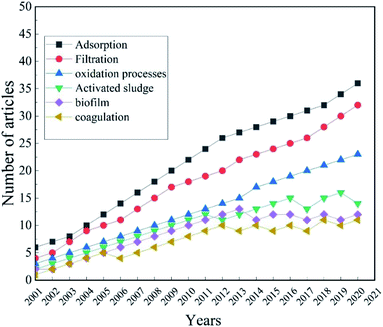 | ||
| Fig. 5 Annual publication performance of the top six (physical, chemical, biological and sludge), mining wastewater treatment technologies. | ||
The adsorption method is one of the most effective methods for the advanced treatment of wastewater, which is usually used to reduce harmful metals. Among them, activated carbon is the most widely used as an adsorbent with a good adsorption capacity for heavy metal ions. In addition, in the study of keyword analysis in Fig. 4 and Table 3, the keywords “heavy metals” and “adsorption” also show a high frequency of co-occurrence.
The adsorption capacity of “activated carbon or fly ash” is related to its porous-sized distribution, large specific surface area, and surface chemistry. However, the use of activated carbon may be expensive depending on its adsorption capacity and the difficulties in reactivation and reuse. Therefore, many researchers have tried to develop cheap and effective adsorbents as alternatives from industry or agriculture e.g., waste carbon slurry, corn cob, coconut shell, recycled cotton waste, nutshells, waste tire rubber, bio-sorbents (chitosan, peat), and so on. Recently “chitosan” has been used for the modification of fly ash for good removal capacity of the adsorbent.
The oxidation processes and coagulation depicted in Fig. 5 indicate that it is a major research topic in chemical treatment methods with 250 and 143 published articles. The oxidation process has shown a clear rising trend, that way we can assume that there is still much scope in chemical treatment technology for the treatment of mining wastewater. Advanced oxidation processes (AOPs), in a broad sense, are a set of chemical treatment procedures designed to remove organic (and sometimes inorganic) materials from water and wastewater by oxidation through reactions with hydroxyl radicals (˙OH).
On the other hand, with a total of 143 published articles, coagulation is the least valued MWWT method compared with other treatment techniques studied in Fig. 5. We can see that the progressing trend of coagulation treatment does not go with consistency compared to adsorption, oxidation, and activated sludge treatment technologies. The line of coagulation treatment has gone up a bit from 2001 to 2005, and then it came down between 2005 and 2006. From 2007 to 2012, it went in an ascending order after that it has been fluctuating again. There can be many reasons behind this, one of which may be the cost of operating the process is relatively high than other treatment methods, and secondly, there is an adverse effect of a sudden change in the character of treated water absorption.
The biological treatment techniques “activate sludge and biofilm” were rarely used in treatment techniques. In Fig. 5, activated sludge and biofilm come in number four and five with 200 and 173 published articles, respectively. As seen, in Fig. 5, the progress trend of both “activated sludge and biofilm” was going up consistently from 2001 to 2013, but after 2012, there were sudden fluctuations till the end. Such fluctuations on the topic of activated sludge could be due to the more attention paid to more efficient ways such as physical and chemical treatment methods.
Physical, as well as chemical methodologies, received extra attention on the laboratory scales and technical or scientific study. However, the applied work uses and patent cover are incomplete because of boundaries in experimental abilities, longer period reserve, higher cost, etc. These results present a great opportunity and a large space for development. Meantime although computerized measurement methods such as the internet of things (IoT), wireless sensor networks (WSN), artificial intelligence, swarming drones, and automation have been widely employed in mine water management, it is particularly important for management and decision-makers to find and choose the right technologies to treat mining wastewater in the vast ocean of research on MWWT.58 Linking mining wastewater treatments by modifying the relationships between numerous structural classifications, however, must be promising, and the inclusion of the double is still a problem routine that needs to be addressed.
The S-curves derived from the articles show that physical, chemical and biological MWWT methods entered the maturity stage in 2019, 2017 and 2016, respectively. Physical and chemical treatment technologies will have a much longer time before reaching the declining stage and have a greater potential for innovation and development. Among these technologies, adsorption, oxidation, and biofilm could be further developed in the next 5–10 years through academic research and novelty. Differently, biological treatment technologies are closer to the saturation stage, e.g., both biofilm and activated sludge will enter the maturity stage around 2025. Both S-curve and publication output indicated the popularity of the physical and biological treatment methods. Physical treatments have developed rapidly in the past ten years, while biological is an ongoing developing technology.
The composition of mining wastewater became more complicated by including a more non-degradable carbon-based materials with the development of the mining industry.59 Physical treatment methods have the advantage of high efficiency, low cost, and convenient operation,60 and have played a crucial role in MWWT. With much attention from researchers and a huge number of studies, the maturity of physical treatment technologies such as adsorption and filtration has improved rapidly.61 In terms of specific technologies, compared with chemical technologies such as “oxidation technology”,62 and biological “biofilm”,63 research on the activated sludge is necessary due to the smaller number of publications it has been presented in the graph.
3.6 Three fields plot of prolific countries, keywords, and journal's network.
A more visualized representation of productive researchers about their countries, keywords, and a particular source of publications in the field of MWWT is shown in Fig. 7. This figure is a three-field plot or Sankey graph of articles offered by countries, keywords, and sources within the field of MWWT. The left-side column represents active countries, the middle column demonstrates the most used keywords by the authors, and the most right column represents the most famous sources relevant to the research field. Note that, the height of the boxes and thickness of the linking lines indicate the proportion of such variables in the total allocation. Across the countries, China has more keyword connections. Even though our previous results discovered that the United States is first concerning scientific invention and citation counts, they came second in affiliation through keywords. In that order, Spain has the next highest volume of keywords, followed by Brazil and South Africa.From the thickness of the lines going from the countries to keywords, and then publication sources, if the thickness of lines is strong, it will show the higher research on the relevant topic, and if the thickness of lines is weak, it will show low research on the topics. So, here are three field Sankey plots in Fig. 7. We can see the interaction between the three fields with the help of the thickness of the lines and boxes, which is an interesting thing. We can see which countries are working on which topic and publishing in which journals. For example, China has been working a lot on acid mine drainage, adsorption, and heavy metal topics compared to other countries; journals such as Environmental Pollution, Journal of Hazard Materials, and Science of the Total Environment are publishing these research articles. If we see the graph from the right side i.e., on the side of the journal the thickness of the box of the Journal of Hazard Material and Science of the Total Environment shows that it has higher publications compared to other journals.
The thickness of the line and box of acid mine drainage show that the most important keyword “acid mine drainage” is used in Fig. 6, and China has been working a lot on acid-mine drainage topics, as compared to other countries. Hence, this shows that acid mine drainage (AMD) is considered to be one of the major environmental issues in the mining industry in China due to high coal mining.64,65 The total number of coal mines in china has decreased from more than 80![[thin space (1/6-em)]](https://www.rsc.org/images/entities/char_2009.gif) 000 to around 4700 (by the end of 2020) under the guidance of a series of national policies, which is a good initiative for the protection of the world's natural water resources and environment.66
000 to around 4700 (by the end of 2020) under the guidance of a series of national policies, which is a good initiative for the protection of the world's natural water resources and environment.66
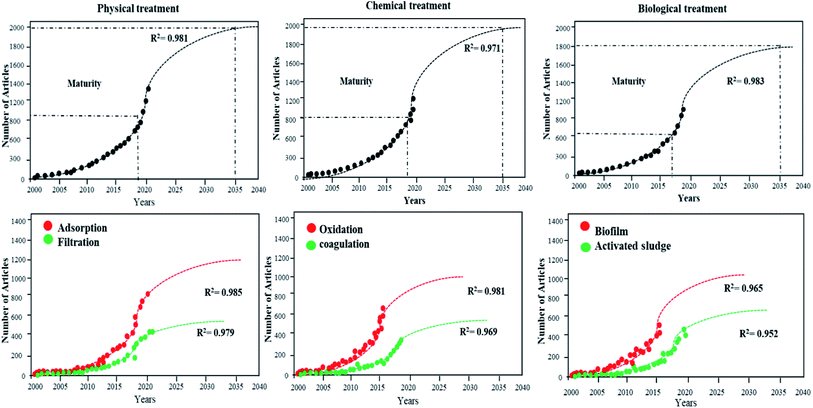 | ||
| Fig. 6 The S-curve analysis of different mining wastewater treatment methods and technologies as derived from the articles. | ||
While Europe has a long and rich history of mining, there are now significantly more uncontrolled mines than operational mines across the continent and research and development activities across Europe are wide-ranging.67 European Union (EU) legislation strongly influences approaches to mine waste/water management in Europe.68 Many European countries Estonia, Finland, France, Germany, Hungary, Italy, Macedonia, Netherlands, Norway, Poland, Serbia and Montenegro, Slovakia, Sweden, United Kingdom are facing problems with acid mine drainage and remediation due to minerals or mining exploited,69 such problems have been brought into sharp focus by catastrophic events at mining facilities,70 as a result, groundwater and surface water pollution are major issues.71
Acid mine drainage, acid metalliferous drainage (AMD), or acid rock drainage (ARD) are caused due to the outflow of acidic water from coal mines (https://en.wikipedia.org/wiki/Coal_mining) or metal mines.72 This acidic water procedure through the chemical reaction of surface water (rainwater, snowmelt, pond water) and shallow subsurface water with rocks that contain sulfur-bearing minerals results in sulfuric acid.73 AMD impacts stream and river ecosystems by increasing acidity, depleting oxygen, and releasing heavy metals such as aluminum (Al3+), iron (Fe3+), manganese (Mn2+), zinc (Zn2+), copper, lead, and mercury, which pollute the ground and surface water.74 AMD is one of mining's most serious threats to human and aquatic life. For instance, acid mine draining can devastate rivers, streams, contaminate drinking water, and aquatic life (aquatic plants and animals) for hundreds and, under the “right” conditions, thousands of years.70
Numerous adsorption, filtration, and sorption technologies are being used for the treatment of AMD. However, the most prevalent method for treating AMD contamination is the addition of alkaline reagents such as lime, limestone, sodium carbonate, or sodium hydroxide.75 This treatment aims at neutralizing acidic water and the precipitation of heavy metals. This includes all necessary pretreatment, ultra-filtration, reverse osmosis, evaporators, and crystallizers.76
3.7 Descriptive analysis of most productive authors and institutions
Collaboration distributes resources among academic institutions, creating conditions for partnerships, finding the latest research, and problem solving, bringing innovations in research, improving research practice, and sharing ideas and research. By institutional analysis, we can reveal the ideas of most collaborative institutions in MWWT and find how much they have interacted individually or collectively with each other. In addition, we can find whether individual institutions have decided to work on this topic or if it was government funding or an opportunity from the private sector.In the sample, 83.87% of the institutions have published ten articles, and 90.88% of institutions have produced ten to fifteen articles. Therefore, we chose at least twenty publications and 30 citations as criteria to extract the most influential institutions in the MWWT field. From Fig. 8(a) and the inserted table, University of Chinese Academy of Sciences, Beijing is ranked as the first in the MWWT area with 43 publications (174 citations and 124 total link strength). The subsequent institutions are the University of Saskatchewan (Canada), and Guangzhou institute of geochemistry (China), with 35 and 31 publications, 111 and 90 citations, 12 and 100 TLS, respectively. In this analysis, the thickness of the line reflects the frequency or TLS of coauthor-ship collaboration among the institutions. The greater TLS values of Chinese research institutes identified their closer collaborative relationships between institutions. The results show that the University of Saskatchewan, Canada, has the least collaboration in MWWT research due to 12 TLS.
Though institutions with the 31 and 30 publications are Guangzhou institute of geochemistry and Harbin institute of technology (China), respectively, and countries with 28 to 19 publications are Taiwan, South Africa, India, Finland, USA, Spain, Turkey, and South Korea, but these countries have strong collaboration among other institutions because of higher TLS than Canada.
Author productive analysis shows the interest, and role of authors' contributions in the research policies, problem-solving, and research innovation progress of his institutions, company, organization, and country development. Fig. 8(b) and the table downside illustrate some important information related to the authors, which are the following: the different colors represent different clusters. Each node in the cluster represents an author. The node's size represents the number of articles published by the authors, and the nodes with the same color represent the relevant information of cooperation between the authors. In the author's knowledge map and table, the total citations show an indicator of the influence of a researcher's work and cited by another researcher, and the TLS represents the size of collaboration among the authors. The greater the TLS, the stronger the collaboration.
About 84.21% of the authors in the sample have published one paper, and 5.4% of the authors have produced seven or more documents. Hence, we analyze the authors who have published at least seven or more papers. Furthermore, considering the impact of the author, we chose the authors whose papers have been cited at least over 90 times.
To understand the relationships between the table and figure of authors, there are two standard weight attributes, referred to the total citations attribute and TLS attribute for a given item, the total citations and TLS qualities, and quantity show the author's performance in the relevant research field. The number of links of an author with other authors, and total citations of an author's publications with other authors have different values and standards. For example, to understand the concept of total citations and TLS, in the case of co-authorship, the citations indicate the number of articles linked with other research articles, and the TLS attribute indicates the total strength of the co-authorship links of a given researcher with other researchers.
According to the results shown in the inserted table of Fig. 7(b), with 15 documents, 120 citations, and 6 TLS, Li Y. can be recognized as the most important author, meaning this author is taking more interest and encouraging research in the MWWT field, and other researcher cited his paper in their research papers. These following authors are Wang J., and Sillanpaa M., the second and third positions authors, respectively, who have published more than ten articles in the field of MWWT research. As a consequence, Li Y. and Wang J. are the authors who are more productive with influential research. Hence, exploration, description, and explanation are the three most influential and common purposes of research among the institutions individually or collectively.
3.8 Evolution processes of MWWT research
Co-word analysis can make good use of the keywords contained in the “time” attribute. Therefore, the dynamic changing process of study discipline study could be presented much more objectively and practically. This work divided the period from 2001 to 2020 into two stages, and the analysis of keywords in each stage is shown in Fig. 9. The domain classification of the two stages is increased. However, the research focused on different directions and the relationship between different fields was also changing over time.Identified from the co-word analysis, treatment technologies, pollution types, mining water applications, stages, theory, and management strategies have always been crucial points, issues, or topics in the study of MWWT research during the entire period.77 In the evolution from stage 1 (2001–2010) to stage 2 (2011–2020), the interconnections of keywords began to become closer. Additionally, there was research concerning China and the U.S.A in this period because of these two countries' size and interconnection, and closeness to each other and with wastewater treatment keywords. In the aspect of the theory, stages of treatment, pollution type, natural treatment, and advanced treatment technologies began to receive attention because of the use of modeling and kinetic theories such as pseudo-first order and second-order kinetics models in treatment research. In both, stage 1 (2001–2010) to stage 2 (2011–2020), new techniques, such as physical, chemical, and biological technologies were introduced into this field,61 while the specific topic was related to the administration or management of waste and disposal.78 In stage 2 (2011–2020), efficient advanced treatment technologies such as ultrafiltration, nanofiltration, revise osmosis (RO),79 oxidation, etc. continue to be concerned. Moreover, this phenomenon indicated that the related research on biosorption and activated carbon was still very rare.
In the present and near future, there are some solutions for treating wastewater from the mining industry such as the full range of wastewater treatment technologies including biological processes, desalination, clarification, evaporation and crystallization, disinfection, filtration, ion exchange, membrane separation, package plants, sludge dewatering and handling, and zero liquid discharge.80 Moreover, integrated steps (conducting a self-assessment, evaluating technology, performing a pump audit, installing smart technology, reviewing data) can help MWWT plants to achieve better water efficiency and realize potential cost savings81 by reducing water waste.82 The analysis of the treatment technologies allows us to understand the current research in MWWT with adsorption, filtration, and oxidation processes that are mainly focused on an experimental scale.83 The evaluation of real conditions in the continuous flow mode is mandatory for large-scale implementation in the mining wastewater industry.84 Portable and fast in situ leak detection technologies, such as paper-based chips85 and microfluidics,86,87 are also necessary to allocate more time for emergency response.
4. Conclusions
The persistence of heavy metals in the environment has attracted the attention of researchers and the public in recent years. With the increasing number of papers on MWWT, bibliometrics helps researchers to understand academic collaboration, research trends, and hot issues. This bibliometrics study looked at 1542 articles from 2001 to 2020 that represented research on MWWT. Through publication analysis, international collaboration analysis, keyword co-occurrence networks, wastewater treatment technology analysis, and authors and institutional analysis have shown that China and the U.S.A have great research flow, while China has the greater international academic research influence. Moreover, the most investigated types of mining wastewater were heavy metal and acid mine drainage, which has sparked a lot of interest due to human and environmental health concerns and can be called research hotspots in recent years. Adsorption processes, membrane filtration processes, oxidation processes, coagulation processes, and activated sludge are the most common joint treatment techniques, which have shown great potential in recent decades because of increased government and social pressure to reduce severe pollution and recover values to preserve the natural environment.In the recent few years, the term “environment pollution and water” has appeared in journals about MWWT. This means that the impact of mining wastewater on the “environment and water” is unclear. Thus, researchers should consider these points. Also, the impact of mining wastewater and heavy metals on human health and aquatic life is unclear. Further studies are required to understand the majority of the questions that remain unknown.
(a) Potential future directions are expressed based on the bibliometric review of the past and present conditions of MWWT research; researchers should pay close attention to related studies in the coming years. A further research study by advanced-level research investigations should be conducted to map target variables that are affecting public health and the environment. This would permit the improvement of a knowledge base for the water treatment and reuse sector in advanced and under developing mining sectors, particularly in water-scarce regions where the value-added benefits are higher. While the international mining industry puts effort into future development over the expanded production, they must not lose sight of working productivity and total cost optimization.
(b) Upcoming years are expected to see permanent positive and helpful investment trends in the mining and wastewater treatment sector improved treatment levels, resource recovery, and desalination capacities.
(c) Prices, policies, and guidelines are also important key drivers in the business atmosphere. The relationship between advanced technologies, the social dimension of suitability, as well as the rules of regulation and guidelines, will be an intentional hot topic for further exploration at the advanced level of this research field.
(d) Many beneficial possibilities for the treatment and recycling of wastewater in the mining industry have been documented, however, some limits require additional research. Heavy metals in wastewater raise alarms due to their ability to persist in the environment and their serious health repercussions. Moreover, studies have shown that mining and tunneling, alongside population development areas, will lead to higher applications of chemicals in the future, which would be a big problem for securing the natural environment.
(e) Consumption of energy is one of the major technical problem that must be addressed in treatment plants where a limited population exists in towns and small cities because it is difficult to provide facilities at a low cost.
(f) The results and conclusions of scientific facts, beliefs, and opinions of researchers and other users differ significantly, which inhibits the development of wastewater applications due to lack of understanding of the associated benefits. Great efforts must be put into the report such conditions to appropriately disseminate scientific knowledge to society as a whole.
Funding
This work was supported by Environment and Conservation Fund (ECF) of Hong Kong SAR, China (Project No. 2018-49) and in part by the National Natural Science Foundation of China (Grant No. 51974200).Author contributions
Aqib Zahoor: investigation, formal analysis, data curation, writing – original draft, writing – review and editing. Mao Guozhu: investigation, conceptualization, resources, supervision, writing – review editing and funding acquisition. Jian Lin Chen: supervision, writing – review editing, investigation, conceptualization and funding acquisition. Xinming Jia: data curation, conceptualization. Xiao Xiao: data curation, writing review and editing.Conflicts of interest
The authors note that they have no known competing financial or personal interests that could have influenced the findings of this study.References
- S. Farzin, F. Nabizadeh Chianeh, M. Valikhan Anaraki and F. Mahmoudian, Introducing a framework for modeling of drug electrochemical removal from wastewater based on data mining algorithms, scatter interpolation method, and multi criteria decision analysis (DID), J. Cleaner Prod., 2020, 266, 122075 CrossRef CAS.
- S. Ahmad, X. Zhu, J. Luo, M. Shen, S. Zhou and S. Zhang, Conversion of phosphorus and nitrogen in lincomycin residue during microwave-assisted hydrothermal liquefaction and its application for Pb2+ removal, Sci. Total Environ., 2019, 687, 1381–1388 CrossRef CAS PubMed.
- A. F. S. Foureaux, V. R. Moreira, Y. A. R. Lebron, L. V. d. S. Santos and M. C. S. Amaral, A sustainable solution for fresh-water demand in mining sectors: Process water reclamation from POX effluent by membrane distillation, Sep. Purif. Technol., 2021, 256, 117797 CrossRef CAS.
- L. B. Grossi, N. C. Magalhães, B. M. Araújo, F. de Carvalho, L. H. Andrade and M. C. S. Amaral, Water conservation in mining industry by integrating pressure-oriented membrane processes for nitrogen-contaminated wastewater treatment: Bench and pilot-scale studies, J. Environ. Chem. Eng., 2021, 9(1), 104779 CrossRef CAS.
- S. M. Samaei, S. Gato-Trinidad and A. Altaee, Performance evaluation of reverse osmosis process in the post-treatment of mining wastewaters: Case study of Costerfield mining operations, Victoria, Australia, J. Water Proc. Eng., 2020, 34, 101116 CrossRef.
- X. Guo, S. Fu, J. Di, Y. Dong and G. Jiang, Study on the Treatment of Acid Mine Drainage Containing Fe2+ and Mn2+ Using Modified Spontaneous Combustion Gangue, J. Renewable Mater., 2021, 9(3), 541–555 Search PubMed.
- N. González-Ipia, K. C. Bolaños-Chamorro, J. D. Acuña-Bedoya, F. Machuca-Martínez and S. F. Castilla-Acevedo, Enhancement of the adsorption of hexacyanoferrate (III) ion on granular activated carbon by the addition of cations: A promissory application to mining wastewater treatment, J. Environ. Chem. Eng., 2020, 8(5), 104336 CrossRef.
- V. Patyal, D. Jaspal and K. Khare. Wastewater Treatment Technologies, A Bibliometric Analysis, Sci. Technol. Libr., 2020, 39(4), 383–394 CrossRef.
- L. Pino, E. Beltran, A. Schwarz, M. C. Ruiz and R. Borquez, Optimization of nanofiltration for treatment of acid mine drainage and copper recovery by solvent extraction, Hydrometallurgy, 2020, 195, 105361 CrossRef CAS.
- A. Zahoor, L. Hai-Hua, C. Jie, H. Sohail, I. Noor and M. Niaz, Causes and Effect by Heavy Metals in Urban and Agriculture Soil, J. Pollut., 2019, 2(1), 7 Search PubMed.
- A. Mike Agbesi Acheampong, An. Ebenezer David Okwaning. Low-Cost Technologies for Mining Wastewater Treatment, J. Environ. Sci. Eng. B, 2017, 6(8), 34245 Search PubMed.
- A. Eberle, J. Besold, J. M. León Ninin, C. F. Kerl, K. Kujala and B. Planer-Friedrich, Potential of high pH and reduced sulfur for arsenic mobilization – Insights from a Finnish peatland treating mining waste water, Sci. Total Environ., 2021, 758, 143689 CrossRef CAS PubMed.
- W. Fu, G. Ji, H. Chen, S. Yang, H. Yang and B. Guo, Engineering Anion Resin based Amorphous Molybdenum Sulphide Composite for Treatment of Authentic Acid Mine Drainage, J. Environ. Chem. Eng., 2020, 8(5), 104072 CrossRef CAS.
- A. Rana and R. Sharma, Drinking Water Quality Assessment and Predictive Mapping: Impact of Kota Stone Mining in Ramganjmandi Tehsil, Rajasthan, India, Nat., Environ. Pollut. Technol., 2020, 19(3), 1219–1225 CrossRef CAS.
- J. Lv, Y. Zheng, X. Tong and X. Li, Clean utilization of waste rocks as a novel adsorbent to treat the beneficiation wastewater containing arsenic and fluorine, J. Cleaner Prod., 2021, 293, 126160 CrossRef CAS.
- R. A. Wuana and F. E. Okieimen, Heavy Metals in Contaminated Soils: A Review of Sources, Chemistry, Risks and Best Available Strategies for Remediation, ISRN Ecol., 2011, 20101, 1–20 Search PubMed.
- S. Z. Ahammad, D. W. Graham and J. Dolfing, Wastewater Treatment: Biological, in Managing Water Resources and Hydrological Systems, ed. B. D. Fath, S. E. Jørgensen and M. Cole, CRC Press, 2nd edn, 2020, pp. 561–576 Search PubMed.
- A. di Biase, V. Wei, M. S. Kowalski, M. Bratty, M. Hildebrand and P. Jabari, Ammonia, thiocyanate, and cyanate removal in an aerobic up-flow submerged attached growth reactor treating gold mine wastewater, Chemosphere, 2020, 243, 125395 CrossRef CAS PubMed.
- E. T. Brewster, S. Freguia, M. Edraki, L. Berry and P. Ledezma, Staged electrochemical treatment guided by modelling allows for targeted recovery of metals and rare earth elements from acid mine drainage, J. Environ. Manage., 2020, 275, 111266 CrossRef CAS PubMed.
- V. Rey, C. A. Ríos, L. Y. Vargas and T. M. Valente, Use of natural zeolite-rich tuff and siliceous sand for mine water treatment from abandoned gold mine tailings, J. Geochem. Explor., 2021, 220, 106660 CrossRef CAS.
- C. Zeng, H. Hu, X. Feng, K. Wang and Q. Zhang, Activating CaCO3 to enhance lead removal from lead-zinc solution to serve as green technology for the purification of mine tailings, Chemosphere, 2020, 249, 126227 CrossRef CAS PubMed.
- T. Carneiro Brandão Pereira, K. Batista dos Santos, W. Lautert-Dutra, L. de Souza Teodoro, V. O. de Almeida and J. Weiler, Acid mine drainage (AMD) treatment by neutralization: Evaluation of physical-chemical performance and ecotoxicological effects on zebrafish (Danio rerio) development, Chemosphere, 2020, 253, 126665 CrossRef PubMed.
- S. Zhan, J. Wu, J. Wang and M. Jing, Distribution characteristics, sources identification and risk assessment of n-alkanes and heavy metals in surface sediments, Tajikistan, Central Asia, Sci. Total Environ., 2020, 709, 136278 CrossRef CAS PubMed.
- C. M. Narayanan and V. Narayan, Biological wastewater treatment and bioreactor design: a review, Sustainable Environ. Res., 2019, 29(1), 33 CrossRef CAS.
- Q. Zheng, Y. Zhang, Z. Zhang, H. Li, A. Wu and H. Shi, Experimental research on various slags as a potential adsorbent for the removal of sulfate from acid mine drainage, J. Environ. Manage., 2020, 270, 110880 CrossRef CAS PubMed.
- B. Hoagland, L. Mosley, T. Russo, J. Kirby, C. Cullen and M. S. Fantle, Arsenic sequestration in gold mine wastes under changing pH and experimental rewetting cycles, Appl. Geochem., 2021, 124, 104789 CrossRef CAS.
- C. Li, D. L. Ramasamy, M. Sillanpää and E. Repo, Separation and concentration of rare earth elements from wastewater using electrodialysis technology, Sep. Purif. Technol., 2021, 254, 117442 CrossRef CAS.
- J. H. Erasmus, W. Malherbe, S. Zimmermann, A. W. Lorenz, M. Nachev and V. Wepener, Metal accumulation in riverine macroinvertebrates from a platinum mining region, Sci. Total Environ., 2020, 703, 134738 CrossRef CAS PubMed.
- Y. Qin, Z. Chen, B. Ding and Z. Li, Impact of sand mining on the carbon sequestration and nitrogen removal ability of soil in the riparian area of Lijiang River, China, Environ. Pollut., 2020, 261, 114220 CrossRef CAS PubMed.
- O. Agboola, D. E. Babatunde, O. S. Isaac Fayomi, E. R. Sadiku, P. Popoola and L. Moropeng, A review on the impact of mining operation: Monitoring, assessment and management, Results Eng., 2020, 8, 100181 CrossRef.
- A. Singh and S. M. Prasad, Remediation of heavy metal contaminated ecosystem: an overview on technology advancement, Int. J. Environ. Sci. Technol., 2015, 12(1), 353–366 CrossRef CAS.
- A. Ashfaq and M. Kaifiyan, Application of Flyash for the Removal of Toxic Metals from Wastewaters through Biosorption, Int. J. Curr. Microbiol. Appl. Sci., 2016, 5(7), 121–125 CrossRef CAS.
- H. Sharififard, M. Nabavinia and M. Soleimani, Evaluation of adsorption efficiency of activated carbon/chitosan composite for removal of Cr (VI) and Cd (II) from single and bi-solute dilute solution, Adv. Environ. Technol., 2016, 13, 215–227 Search PubMed.
- I. F. Macías-Quiroga, P. A. Henao-Aguirre, A. Marín-Flórez, S. M. Arredondo-López and N. R. Sanabria-González, Bibliometric analysis of advanced oxidation processes (AOPs) in wastewater treatment: global and Ibero-American research trends, Environ. Sci. Pollut. Res., 2021, 28(19), 23791–23811 CrossRef PubMed.
- G. Mao, T. Shi, S. Zhang, J. Crittenden, S. Guo and H. Du, Bibliometric analysis of insights into soil remediation, J. Soils Sediments, 2018, 18(7), 2520–2534 CrossRef.
- G. Mao, H. Hu, X. Liu, J. Crittenden and N. Huang, A bibliometric analysis of industrial wastewater treatments from 1998 to 2019, Environ. Pollut., 2021, 275, 115785 CrossRef CAS PubMed.
- G. S. Colares, N. Dell’ Osbel, P. G. Wiesel, G. A. Oliveira, P. H. Z. Lemos and F. P. da Silva, Floating treatment wetlands: A review and bibliometric analysis, Sci. Total Environ., 2020, 714, 136776 CrossRef CAS PubMed.
- L. Semerjian and G. M. Ayoub, High-pH–magnesium coagulation–flocculation in wastewater treatment, Adv. Environ. Res., 2003, 7(2), 389–403 CrossRef CAS.
- A. Barragán-Ocaña, P. Silva-Borjas and S. Olmos-Peña, Scientific and technological trajectory in the recovery of value-added products from wastewater: A general approach, J. Water Proc. Eng., 2021, 39, 101692 CrossRef.
- R. Pranckutė, Web of Science (WoS) and Scopus: The Titans of Bibliographic Information in Today's Academic World, Publications, 2021, 9(1), 12 CrossRef.
- M. Jiang, Y. Qi, H. Liu and Y. Chen, The Role of Nanomaterials and Nanotechnologies in Wastewater Treatment: a Bibliometric Analysis, Nanoscale Res. Lett., 2018, 13(1), 233 CrossRef PubMed.
- T. C. Ekundayo, A. Igwaran, Y. D. Oluwafemi and A. I. Okoh, Global bibliometric meta-analytic assessment of research trends on microbial chlorine resistance in drinking water/water treatment systems, J. Environ. Manage., 2021, 278, 111641 CrossRef CAS PubMed.
- L. Zhao, T. Dai, Z. Qiao, P. Sun, J. Hao and Y. Yang, Application of artificial intelligence to wastewater treatment: A bibliometric analysis and systematic review of technology, economy, management, and wastewater reuse, Process Saf. Environ. Prot., 2020, 133, 169–182 CrossRef CAS.
- N. J. Van Eck and L. Waltman, Software survey: VOSviewer, a computer program for bibliometric mapping, Scientometrics, 2010, 84(2), 523–538 CrossRef PubMed.
- W. Chen, W. Liu, Y. Geng, M. T. Brown, C. Gao and R. Wu, Recent progress on emergy research: A bibliometric analysis, Renewable Sustainable Energy Rev., 2017, 73, 1051–1060 CrossRef.
- E. Celik, A. Durmus, O. Adizel and H. Nergiz Uyar, A bibliometric analysis: what do we know about metals(loids) accumulation in wild birds?, Environ. Sci. Pollut. Res., 2021, 28(8), 10302–10334 CrossRef CAS PubMed.
- Y. Li, Y. Rong, U. M. Ahmad, X. Wang, J. Zuo and G. Mao, A comprehensive review on green buildings research: bibliometric analysis during 1998–2018, Environ. Sci. Pollut. Res., 2021, 28, 46196–46214 CrossRef PubMed.
- A. T. Ubando, A. D. M. Africa, M. C. Maniquiz-Redillas, A. B. Culaba, W.-H. Chen and J.-S. Chang, Microalgal biosorption of heavy metals: A comprehensive bibliometric review, J. Hazard. Mater., 2021, 402, 123431 CrossRef CAS PubMed.
- A. Alkhouzaam and H. Qiblawey, Functional GO-based membranes for water treatment and desalination: Fabrication methods, performance and advantages. A review, Chemosphere, 2021, 274, 129853 CrossRef CAS PubMed.
- G. Mao, T. Shi, S. Zhang, J. Crittenden, S. Guo and H. Du, Bibliometric analysis of insights into soil remediation, J. Soils Sediments, 2018, 18(7), 2520–2534 CrossRef.
- G. Crini and E. Lichtfouse, Advantages and disadvantages of techniques used for wastewater treatment, Environ. Chem. Lett., 2019, 17(1), 145–155 CrossRef CAS.
- M. Kumar and K. Pakshirajan, Continuous removal and recovery of metals from wastewater using inverse fluidized bed sulfidogenic bioreactor, J. Cleaner Prod., 2021, 284, 124769 CrossRef CAS.
- Y. Deng and R. Zhao, Advanced Oxidation Processes (AOPs) in Wastewater Treatment, Curr. Pollut. Rep., 2015, 1(3), 167–176 CrossRef CAS.
- X. Cai, L. Kong, X. Hu and X. Peng, Recovery of Re(VII) from strongly acidic wastewater using sulphide: Acceleration by UV irradiation and the underlying mechanism, J. Hazard. Mater., 2021, 416, 126233 CrossRef CAS PubMed.
- B. M. Al-Shehri, M. O. Shkir, T. M. Bawazeer, S. AlFaify and M. S. Hamdy, A rapid microwave synthesis of Ag2S nanoparticles and their photocatalytic performance under UV and visible light illumination for water treatment applications, Phys. E, 2020, 121, 114060 CrossRef CAS.
- D. J. Barker and D. C. Stuckey, A review of soluble microbial products (SMP) in wastewater treatment systems, Water Res., 1999, 33(14), 3063–3082 CrossRef CAS.
- O. Nowak, V. Kuehn and M. Zessner, Sludge management of small water and wastewater treatment plants, Water Sci. Technol., 2004, 48(11–12), 33–41 CrossRef.
- K. S. More, C. Wolkersdorfer, N. Kang and A. S. Elmaghraby, Automated measurement systems in mine water management and mine workings – A review of potential methods, Water Resour. Ind., 2020, 24, 100136 CrossRef.
- H. Lu, S. Liu, H. Zhang, Y. Qiu, J. Zhao and Z. Zhu, Decontamination of Arsenic in Actual Water Samples by Calcium Containing Layered Double Hydroxides from a Convenient Synthesis Method, Water, 2018, 10(9), 1150 CrossRef.
- N. Prakash, P. N. Sudha and N. G. Renganathan, Copper and cadmium removal from synthetic industrial wastewater using chitosan and nylon 6, Environ. Sci. Pollut. Res., 2012, 19(7), 2930–2941 CrossRef CAS PubMed.
- N. N. Rudi, M. S. Muhamad, L. Te Chuan, J. Alipal, S. Omar and N. Hamidon, Evolution of adsorption process for manganese removal in water via agricultural waste adsorbents, Heliyon, 2020, 6(9), e05049 CrossRef PubMed.
- M. A. Acheampong and E. D. O. Ansa, Low-cost technologies for mining wastewater treatment, J. Environ. Eng. Sci., 2017, 6, 391–405 Search PubMed.
- O. S. Ayanda, O. S. Fatoki, F. A. Adekola, B. J. Ximba, O. S. Akinsoji and L. F. Petrik, Coal fly ash supported nZnO for the sorption of triphenyltin chloride, Arch. Environ. Prot., 2015, 41(1), 59–71 Search PubMed.
- Z. Wang, Y. Xu, Z. Zhang and Y. Zhang, Review: Acid Mine Drainage (AMD) in Abandoned Coal Mines of Shanxi, China, Water, 2020, 13(1), 8 CrossRef.
- Y. Dong, F. Liu, X. Qiao, L. Zhou and W. Bi, Effects of Acid Mine Drainage on Calcareous Soil Characteristics and Lolium perenne L. Germination, Int. J. Environ. Res. Public Health, 2018, 15(12), 2742 CrossRef CAS PubMed.
- D. Chen, Q. Feng and H. Liang, Effects of Long-Term Discharge of Acid Mine Drainage from Abandoned Coal Mines on Soil Microorganisms: Microbial Community Structure, Interaction Patterns and Metabolic Functions, Environ. Sci. Pollut. Res., 2021, 28, 53936–53952 CrossRef CAS PubMed.
- A. P. Jarvis, L. Alakangas, B. Azzie, L. Lindahl, J. Loredo and F. Madai, Developments and Challenges in the Management of Mining Wastes and Waters in Europe, 2018, vol. 12 Search PubMed.
- T. Hámor, Sustainable Mining in the European Union: The Legislative Aspect, Environ. Manage., 2004, 33(2), 252–261 CrossRef PubMed.
- W. Hogland, M. Hogland and M. Marques, Enhanced Landfill Mining: Material recovery, energy utilisation and economics in the EU (Directive) perspective, 2018, vol. 12 Search PubMed.
- J. Pope, N. Newman, D. Craw, D. Trumm and R. Rait, Factors that influence coal mine drainage chemistry West Coast, South Island, New Zealand, N. Z. J. Geol. Geophys., 2010, 53(2–3), 115–128 CrossRef CAS.
- P. Gombert, O. Sracek, N. Koukouzas, G. Gzyl, S. T. Valladares and R. Frączek, An Overview of Priority Pollutants in Selected Coal Mine Discharges in Europe, Mine Water Environ., 2019, 38(1), 16–23 CrossRef CAS.
- K. S. Shabani, F. D. Ardejani, K. Badii and M. E. Olya, acid mine drainage treatment by perlite nanomineral, batch and continuous systems, Arch. Min. Sci., 2014, 59(1), 107–122 CAS.
- J. Martínez, J. Rey, M. C. Hidalgo, J. Garrido and D. Rojas, Influence of measurement conditions on the resolution of electrical resistivity imaging: The example of abandoned mining dams in the La Carolina District (Southern Spain), Int. J. Miner. Process., 2014, 133, 67–72 CrossRef.
- M. Rodríguez-Galán, F. M. Baena-Moreno, S. Vázquez, F. Arroyo-Torralvo, L. F. Vilches and Z. Zhang, Remediation of acid mine drainage, Environ. Chem. Lett., 2019, 17(4), 1529–1538 CrossRef.
- E. S. Castro Neto, A. B. S. Aguiar, R. P. Rodriguez and G. P. Sancinetti, Acid mine drainage treatment and metal removal based on a biological sulfate-reducing process, Braz. J. Chem. Eng., 2018, 35(2), 543–552 CrossRef CAS.
- M. Masukume, M. S. Onyango and J. P. Maree, Sea shell derived adsorbent and its potential for treating acid mine drainage, Int. J. Miner. Process., 2014, 133, 52–59 CrossRef CAS.
- S. Ahmad, X. Zhu, J. Luo, S. Zhou, C. Zhang and J. Fan, Phosphorus and nitrogen transformation in antibiotic mycelial residue derived hydrochar and activated pyrolyzed samples: Effect on Pb (II) immobilization, J. Hazard. Mater., 2020, 393, 122446 CrossRef CAS PubMed.
- H. Zhao, F. Song, F. Su, Y. Shen and P. Li, Removal of Cadmium from Contaminated Groundwater Using a Novel Silicon/Aluminum Nanomaterial: An Experimental Study, Arch. Environ. Contam. Toxicol., 2021, 80(1), 234–247 CrossRef CAS PubMed.
- V. K. Gupta and S. Sharma, Removal of Cadmium and Zinc from Aqueous Solutions Using Red Mud, Environ. Sci. Technol., 2002, 36(16), 3612–3617 CrossRef CAS.
- X. Xu, L. Lin, C. Papelis and P. Xu, Sorption of Arsenic from Desalination Concentrate onto Drinking Water Treatment Solids: Operating Conditions and Kinetics, Water, 2018, 10(2), 96 CrossRef.
- G. Mao, Y. Han, X. Liu, J. Crittenden, N. Huang and U. M. Ahmad, Technology status and trends of industrial wastewater treatment: A patent analysis, Chemosphere, 2022, 288, 132483 CrossRef CAS PubMed.
- Y. Liu, J. Zhang, H. Huang, Z. Huang, C. Xu and G. Guo, Treatment of trace thallium in contaminated source waters by ferrate pre-oxidation and poly aluminium chloride coagulation, Sep. Purif. Technol., 2019, 227, 115663 CrossRef CAS.
- A. Angelakis and S. Snyder, Wastewater Treatment and Reuse: Past, Present, and Future, Water, 2015, 7(12), 4887–4895 CrossRef CAS.
- J. A. Garrido-Cardenas, B. Esteban-García, A. Agüera, J. A. Sánchez-Pérez and F. Manzano-Agugliaro, Wastewater Treatment by Advanced Oxidation Process and Their Worldwide Research Trends, Int. J. Environ. Res. Public Health, 2019, 17(1), 170 CrossRef PubMed.
- Q. Sun, N. F. Y. Tam, J. Han, W. Y.-K. Peng, Z. Zhu and J. L. Chen, A simple paper-based colorimetric analytical device for rapid detection of Enterococcus faecalis under the stress of chlorophenols, Talanta, 2021, 225, 121966 CrossRef CAS PubMed.
- R. Ortiz, J. L. Chen, D. C. Stuckey and T. W. J. Steele, Poly(methyl methacrylate) surface modification for surfactant-free real-time toxicity assay on droplet microfluidic platform, ACS Appl. Mater. Interfaces, 2017, 9, 13801–13811 CrossRef CAS PubMed.
- R. Ortiz, J. L. Chen, D. C. Stuckey and T. W. J. Steele, Rapid serial diluting biomicrofluidic provides EC50 in minutes, Micro Nano Eng., 2019, 2, 92–103 CrossRef.
| This journal is © The Royal Society of Chemistry 2022 |

